An American in Vietnam
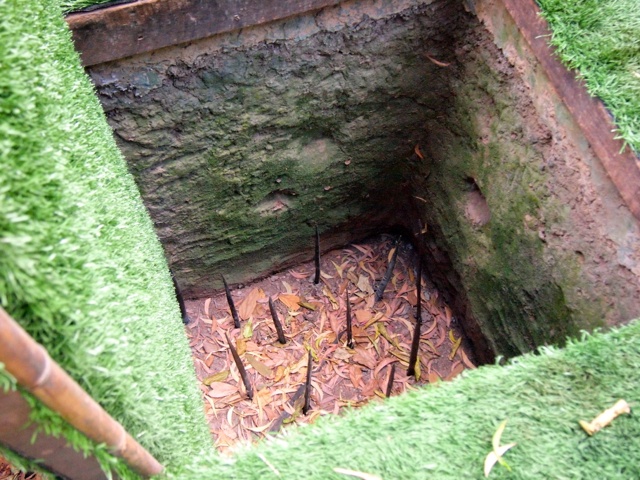
Our guide was almost gleeful as he described the booby traps to us. Pointing out the sharp, rusted bits of metal repurposed from blown-out tanks and unexploded bombs that would be driven through the soft, fleshy bits of enemies.
One by one, he described them. Demonstrating with his words how they worked. Traps that would drive nails through the neck and armpits; traps that would release a swinging beam full of metal spikes through an opened doorway; traps that would catch and mangle feet and ankles.
“These are for American soldiers,” our guide said with a slight smile. A glint in his eye told me that he would have been happy to have witnessed some of them in action.
Our guide's opinion toward “American soldiers” at the Cu Chi Tunnels is not an uncommon one in many parts of Vietnam. After all, he told us that several of his immediate family members (a father, an uncle) fought against the U.S. troops back in the '60s and '70s in what is usually referred to by my country as the Vietnam War.
In my guide's country, though? Here, it was the American War.
There are plenty of things my country has done in the past that I am not proud of. Slave ownership and abuse. Internment camps during WWII. And, of course, the Vietnam War.
In high school, the Vietnam conflict took up a large portion of my American history class. We learned about the terrible things that BOTH sides did to each other; about napalm and Agent Orange and booby traps and barbaric massacres of innocent people. We read books. We watched movies. But it's still not an easy war to dissect, mostly because of the fact that the war is still a very controversial one. And it's also not always easy to succinctly explain WHY we were fighting in the jungles of Vietnam in the first place.
The non-Americans in my Cu Chi tour group were perplexed by this. “But why was the war begun?” they kept asking. I would just shift uncomfortably because I didn't have a simple answer. Maybe there IS no simple answer. “To stop communism,” we usually say. But it was more complicated than that.
The fact of the matter is that my country invaded another. Innocent people died; whole cities were destroyed; horrific gases and poisons were used that have left both physical and mental scars on the people who survived.
I could sort of understand, then, when my guide at the Cu Chi Tunnels made off-color comments about Americans; when he made fun of our fat asses as we tried to climb down into the tiny tunnel entrances. It's not like this war happened 100 years ago. For many people in Vietnam, it is still very fresh in their minds. Especially at a place like this, where the war is discussed every day.
At the Cu Chi Tunnels, hundreds — maybe thousands — of tourists show up each day to marvel at the tiny hidden entrances that lead to more than 200 kilometers (125 miles) of underground tunnels around Saigon. Tunnels that people not only hid and fought in, but tunnels that they actually LIVED in for years. The tourists laugh at one another trying to squeeze into these tunnels; snap some photos and maybe pay money to shoot a machine gun.
They listen to the presentation about the booby traps, and then watch an old newsreel video showing Viet Cong soldiers shooting guns and receiving awards for being “American Killer Heroes” before being herded back out the front gates.
This was the point where I found myself conflicted.
On the one hand, war is war. People kill one another and are awarded medals and honors for it. I realize that. Politicians in my own country run on platforms built around the fact that they are “war heroes.” It should not have been a shock that it's the same in Vietnam.
On the other hand, being confronted by something bad that your country did in the past and then being asked to feel guilty about it… that is something else entirely. It's true that it's not always pleasant to be presented with unfortunate or uncomfortable truths. But, mostly thanks to our tour guide, I almost felt under attack by the time I left the Cu Chi Tunnels, despite the fact that I was not even alive when the U.S. went to war in Vietnam. If I had been, I certainly would not have supported it.
The next day we visited the War Remnants Museum in Saigon — a museum containing a good deal of one-sided, anti-American propaganda.
Even though there WAS a small section on protests against the war in the U.S., again, I felt as though the popular tourist attraction was begging for me to claim some sort of responsibility as an American. To walk through the rooms of disturbing photos (which comprise the majority of the museum) and feel guilty about them.
On the one hand, I suppose this is fair. The U.S. really has never apologized for what it did in Vietnam (or in Laos or Cambodia — in fact, the government is still unwilling to admit that we did ANYthing in some of these places). It is fair to want to place blame and demand that guilt be felt. After all, I would probably feel the same way if the roles had been reversed and it was MY country being invaded and bombed and poisoned like Vietnam was.
But I'm not sure that these one-sided tourist attractions are the way to ask for that responsibility to be claimed.
Don't get me wrong — I'm glad that places like the Cu Chi Tunnels and the War Remnants Museum exist. What the U.S. did in Southeast Asia in the 1960s and '70s was largely uncalled for and needlessly brutal. It dropped more than 3 times as many tons of bombs during the Vietnam War than in the whole of WWII. Which is ridiculous.
And it's right for Vietnam to want the U.S. to take responsibility.
The thing is, in places like the War Remnants Museum (and also to some extent at the Cu Chi Tunnels) Americans are made out to be monsters.
And it's true, of course, that some American soldiers did some monstrous things in Vietnam. We've all seen the photos and read the stories; we've learned about the My Lai Massacre and can picture Napalm Girl in our minds.
But what these places don't tell you is that the majority of young Americans sent to fight in Vietnam did not go willingly. The war, overall, was not popular in the United States. In fact, there were massive, sometimes violent protests against it — 4 students at my alma mater of Kent State University lost their lives in 1970 protesting this war.
The U.S. government enacted a draft to conscript troops to send over to Southeast Asia in 1969, and most of the soldiers sent there had no choice. This of course doesn't excuse the inhumane things that some of them did; but it's worth remembering that there are always two sides to every story — especially when war is involved.
In many cases, the American troops suffered just as much as the Vietnamese did. They developed drug addictions. They suffered traumas. They, too, were affected by things like Agent Orange. Most Americans today will agree that the Vietnam War was a war we should have never been fighting.
But these are things that museums and tourist attractions in Vietnam will barely tell you, if at all.
Before I went to Vietnam, I had a lot of people expressing concerns for my safety.
After all, I was an American traveling to Vietnam. Wouldn't that be dangerous?
Well actually, no. Yes, it's true that the American soldiers who fought here decades ago are still hated in many parts of Vietnam. And some people (perhaps like my guide at the Cu Chi Tunnels) still harbor sour feelings toward the U.S.
But, in most places, nobody had anything bad to say about my being an American. I felt welcomed. I felt safe. I won't say that they've forgotten… just that they are moving past it and realizing that I am not the one responsible for the bombs that fell in their country all those years ago. Other than that one tour guide at the Cu Chi Tunnels, I did not meet one person in Vietnam who narrowed their eyes at me upon learning that I was American.
The people of this country realize that not all Americans are evil, and are able to differentiate between me (a tourist interested in learning about their country) and the American government that sent boys with guns here 40 years ago.
The problem is that the government-run museums and tourist attractions don't really reflect this attitude.
So what's the whole point of this post? Well, to be honest, I'm not sure I have one. War is never an easy topic to address, especially a war with such confusing motivations and devastating consequences.
Visiting the Cu Chi Tunnels and the War Remnants Museum forced me, an American, to look at the Vietnam War slightly differently. They forced me to see it through other eyes — eyes of the locals, and eyes of non-American tourists, many of whom were learning about the conflict for the first time.
Did the one-sidedness bother me? Yes. But did it also make me look in the hypothetical mirror a bit differently? Yes, it did that, too.
I don't have a solution for dealing with tourist sites like the Cu Chi Tunnels and War Remnants Museum. Do I believe that these places are biased in the information they share and the manner in which it is presented? Yes, I definitely do.
But do I, as an American, have any right to demand that they be changed?
No, I don't believe that I do.
All I ask is that, if you visit these places yourself, keep in mind that you are only being shown part of the story.
And remember that these types of propaganda-heavy attractions do not necessarily reflect the overall opinions of people living in Vietnam today.
Have you been to any of these sites? Would you want to go as an American?
*Note: I visited these sites as part of a complimentary tour of Vietnam and Cambodia with Intrepid Travel. The guide at the Cu Chi Tunnels mentioned in this post was not affiliated with Intrepid at all. As always, opinions and observations are completely my own.

Amanda Williams is the award-winning blogger behind A Dangerous Business Travel Blog. She has traveled to more than 60 countries on 6 continents from her home base in Ohio, specializing in experiential and thoughtful travel through the US, Europe, and rest of the world. Amanda only shares tips based on her personal experiences and places she's actually traveled!

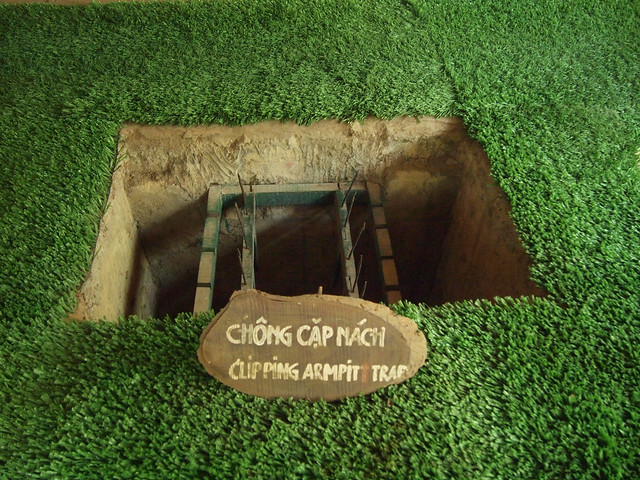
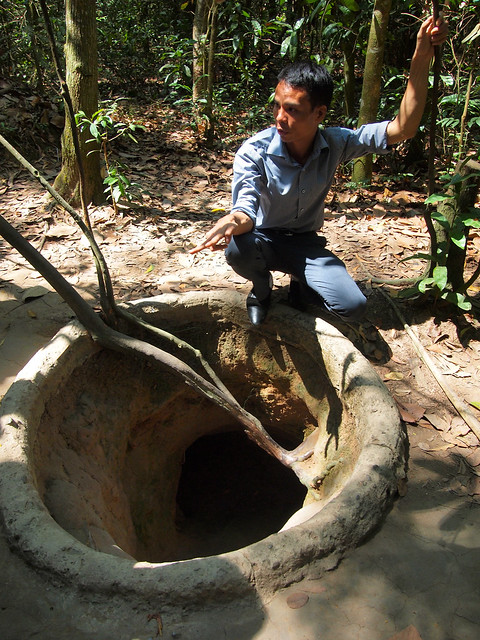
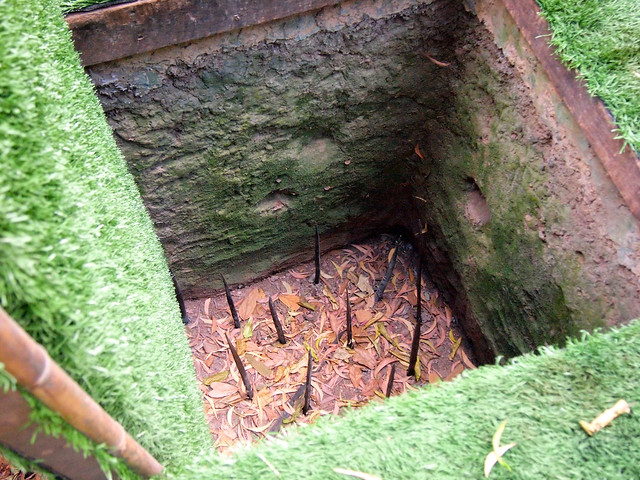
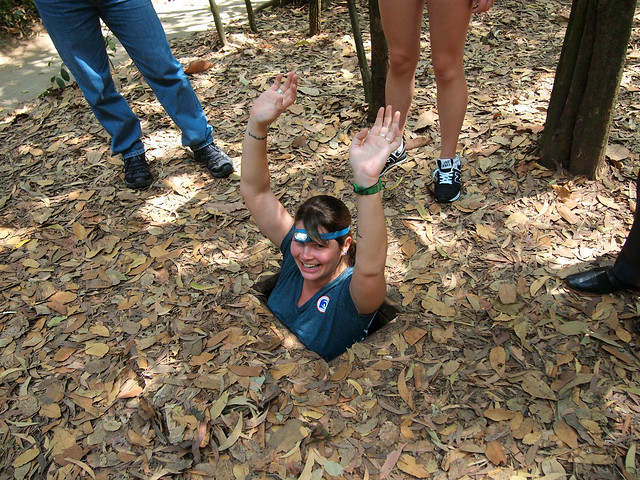
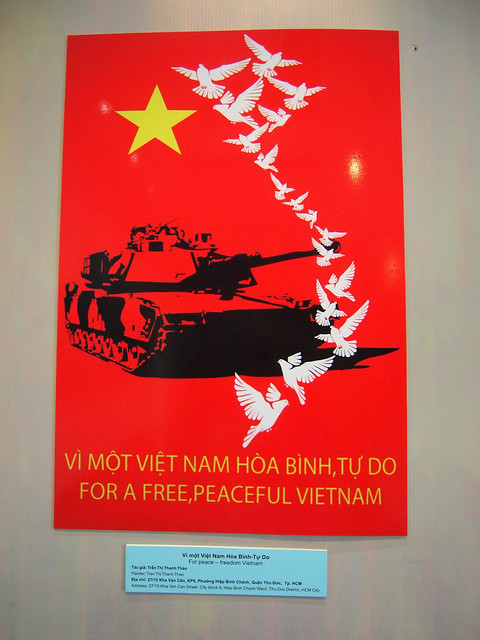
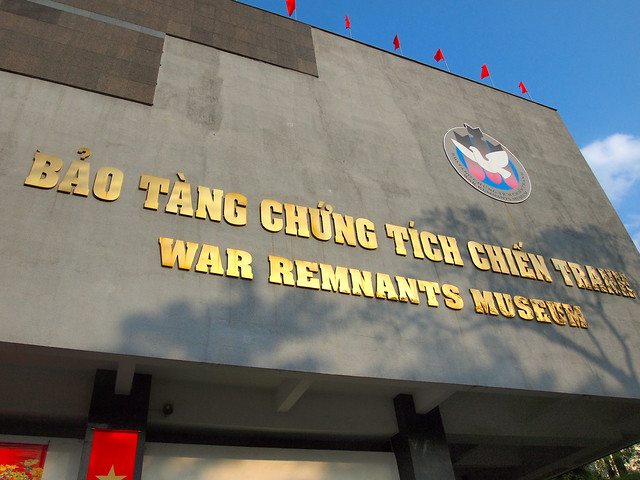
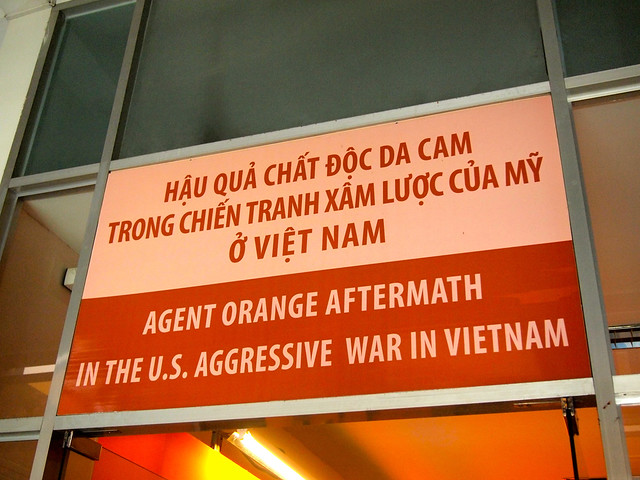
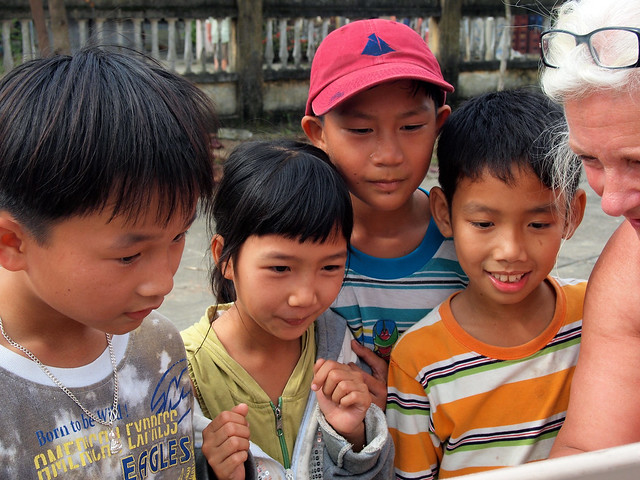
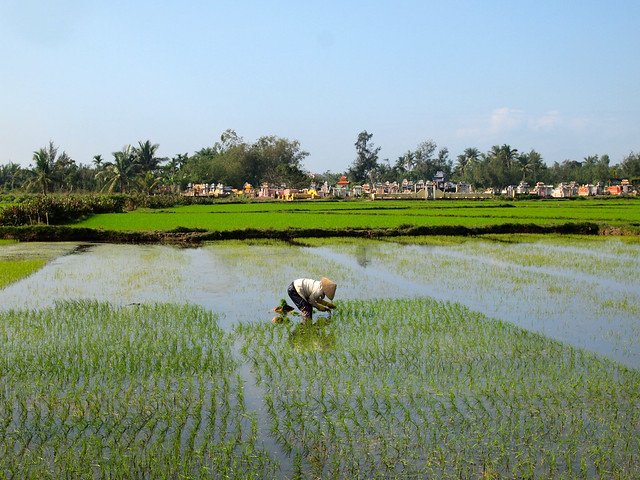









Very well written, tasteful, and thought-provoking post. Thank you so much for sharing your experience.
Happy travels 🙂
Thanks so much, Lauren. This one took me a long time and I really had no idea what sort of response it would get. So glad it’s making people think.
My dad was one of those American soldiers who fought in Vietnam unwillingly. I never even knew until I was about eight years old. I was helping to clean out the attic and found his Purple Heart. I still don’t know how he earned it even – my mom explained what it was, but my dad does not talk about his time in Vietnam. It’s a very painful time for him to remember even all these years later. My own husband is serving in the US military and has been deployed to places like Afghanistan, yet my dad won’t talk about his experiences.
Some Americans indeed committed horrific acts in Vietnam, but many were involuntarily there and still suffer today of PTSD from the horrific things they saw (though that term certainly didn’t exist back then).
Yes there’s no doubt that American soldiers sent over there suffered, too. And that fact that many Americans were so horrible to them when they returned home… that embarrasses me, too.
I had a similar reaction while in Vietnam. The war still felt very present in the country’s mindset and I found the Cu Chi Tunnels and War Remnants Museum to be super one-sided. In fact, I had originally planned on seeing the DMZ too but after the sites in Saigon I thought it would be just more of the same. But like you, I also felt very welcomed by almost everyone I met. I felt safe. I learned a lot! I’d love to go back some day but I’d probably skip all the war sites next time.
Yeah, I’m not sure if I would visit these specific places again either, but I will most definitely return to Vietnam someday! I loved the country.
I am really sorry to hear that. I do not agree with you. I’m polish (so I know something about war crimes, plus I’ve got MA in History) and I must admit that attitude prevalent in Vietnam is extremely positive towards Americans.
I dont base my opinion only on my experience but I am also taking into consideration voices of others (I talked with both Vietnamese and Americans).
For example, I met a former American marine in Vietnam who fought in Vietnam war and he was travelling and visiting “the old” places. He said that the whole country “welcomed” him very positively and he didnt get the feeling you got after visiting the museum and Cu Chi tunnels. Above all, the museum is not one sided! There is a room showing protests and support even from the US, thus not the whole country was supporting the war etc…it makes an impression that you had already had an opinion before visiting it).
I know it is a hard topic (it is disappointing you do not understand why Americans got involved, it is basic understanding of the Cold War and its strategies) and you tried to cover all the aspects, however I feel like you really dont realize how fast those people forgot (got over) the Americans and all the horrible crimes they commited like…40-50 years go…
I’m not sure you read my entire post, Dagmara. I clearly state at the end that, in general, the *people* of Vietnam are welcoming and open to Americans. I agree that the overall attitude in Vietnam is positive toward Americans these days, which honestly amazes me.
As for my personal experiences… well, they are just that – MY experiences. I had a very poor guide at the Cu Chi Tunnels, which obviously colored my experience there. I’ve talked to plenty of others who had similar experiences, though – you can see their comments on this post, too.
And I think if you talked to most Americans (even those who do understand “Cold War strategies”) they would have a hard time explaining why we invaded Vietnam in a way that actually makes it sound like it was necessary.
It really astonished me that most Americans would have hard time explaining why you invaded Vietnam in a way that makes it sound like it was necessary…wait a moment, this is a basic knowledge of the Cold War strategies, namely the containment doctrine. I dont know how and why somebody could not explain it to you. Americans wanted to keep Laos neutral and North Vietnam didnt make it easy. It is a complex geopolitic situation that covers many aspects…like actions of Soviet Union, Communist China, situation in Europe..etc
I see that you had a bad guide, but I dont see that you had a bad experience. You claim that positive attitude was prevalant and you were amazed with it, however I got the impression that the historic encounter made you feel uncomfortable and your thoughts are still not clarified (you give a critique opinion about Vietnam or their beliefs (“Americans are made out to be monsters” it is a really subjective thought), but then somehow you repel some of it or the example does not show the full image): “But what these places don’t tell you is that the majority of young Americans sent to fight in Vietnam did not go willingly.” The 1970 protests (and others all around the world) were covered in the Museum.
I’m not going to argue with you, Dagmara. That’s not what this post (or my site) is about. Thank you for your input, but please respect that I am entitled to interpret my own personal experience. It is perfectly possible, I think, to have both a positive attitude towards Vietnamese people and Vietnam, and yet an uncomfortable experience at a few specific sites. The same was true for me in Cambodia. I’m sorry that I do not also hold an MA in history. Mine is in tourism.
I didn’t have the chance to visit the museum, but I did make it to the tunnels. I had a lot of the same feelings, and I’m not sure I ever made complete sense of it.
I do remember people telling me how, “you can always just tell people you are Canadian” or other American tourists doing the same. To me that was just so ridiculous. It’s like you are assuming you are actually guilty when you do that.
No matter where you go, the people of a country are not a direct reflection of the government at all.
Great post!
I HATE when Americans go around telling people they are Canadian! I’m glad you didn’t; I would never dream of doing it, either. Mostly because, like you said, the locals usually don’t hold it against you, even if they aren’t a fan of our government.
Beautifully written, a very interesting read for me, also an American who recently traveled in Vietnam. Like you I did not experience any anti-American sentiment from the people during my time in Vietnam. In fact many were interested and excited when I told them where I was from. One woman hugged and kissed my cheeks and told me that her grandfather, whom she never met, was an American. The War Museum in Saigon I will admit is quite nationalistic, however I have to disagree that they did not acknowledge US protests against the war. On the first floor of the museum there is an entire section with photos of protests, statements by those who publicly burned themselves, and even the war medals donated by an American soldier with an apology letter. Walking through the museum, generally I felt like my education system had brushed over the devastation of the war. The fact that people born today are still being affected by agent orange and that Cambodia is still covered in land mines is absolutely horrific and totally unacceptable. I left feeling much more frustrated with the US government than with Vietnam. However, perhaps that’s just how strong their propaganda was? Either way, the guide making those comments is so not cool and I would have been peeved myself.
The legacy of the Vietnam War is indeed horrific and unacceptable – especially since the U.S. government has largely pushed most of it under the rug. I think the average American, though, sees it much more like you and I. Leaving these places being frustrated at the U.S. I think is the point; a totally understandable reaction. They definitely made me re-think things, too.
Well done Amanda ,you make me want to go again and re evaluate..I didn’t know much at all about the war when I went on that tour..\travel and writers like you.are so educating .A great post Amanda thank you .
Thanks so much, Robin. Comments like this one mean a lot. Travel, for me, is such an educational experience. And so being able to learn things and then share them on my blog is such a great thing!
Fascinating post. I think tourist attractions like this are important to remind us of what happened in the past and hopefully keep these kinds of mistakes from happening again, but it can make for some discomfort too. When we were in Hawaii it was interesting to watch the video at Pearl Harbor in a room full of American and Japanese tourists because of the palpable discomfort, and then watch a video at another museum about what Americans did to the native Hawaiians and feel discomfort there.
There is always discomfort when it comes to painful history like this. But I always think it’s worth it, in the end.
You’ve put together a solid post here with some interesting points of view from a couple of different sides. Having studied the Vietnam war quite a bit I just wanted to share a couple points of insight here that might help clarify a couple of things. Firstly when you look at Vietnam today it’s a unified country, but at the time of the American/Vietnam War the country was plainly divided into South and North Vietnam much like North and South Korea are today. The American involvement in Vietnam was brought about by several core factors. There was a concern that if Communism spread throughout the entire country of Vietnam it would then cause a “domino effect” and result in the entire Indochinese peninsula turning red. Remember the war started in the late 50’s at the tail end of the second “red scare” (mcCartyhyism etc) and less than a decade after the end of the Korean War, not the mid 60’s like popularly believed.
American Involvement began when the South Vietnamese govt requested assistance and the US sent clandestine “advisers” (early special forces units etc) to teach and train South Vietnamese forces on how to combat against the North Vietnamese forces (NVA). As the war effort escalated and troop levels increased the conflict then grew to it’s enormous scale. Eventually the US pulled out in the early 70’s which resulted in the fall of Saigon to Hanoi and it’s renaming to Ho Chi Minh City. When you look at these museums, memorials, and other tidbits of war propaganda it’s important to remember that none of it represents the side of the South Vietnamese nation which we were defending.
Thanks for those helpful additions! And yes, you’re right that these places don’t represent the South Vietnamese side – because it’s always so closely tied to the “American side.” But, like I said in my post, I don’t think these places represent the attitudes of most Vietnamese today, period.
In fact, I asked various tour guides I had throughout Vietnam about the division and the war and all that. And not only did they say that most Vietnamese today have more hostile feelings toward the Chinese than they do toward Americans, but they also said that most Vietnamese don’t view the country as having been quite so “divided” into North and South as we usually learn over on this side of the world. It was very much a governmental division, from the sounds of it.
I’m very surprised that your studies of Vietnam war did not reveal key historical facts which guide better understanding of complex tragedy:
. The US involved in Vietnam war right after WWII, financing 90% of the French return costs and provided air covers for French forces at the famous Dien Bien Phu battle which ended French colonial connection. Furthermore, the US armed and trained the 1st organized Communist (Viet Minh) army to fight against Japanese occupation forces on behalf on the Allies. In 1945, after the defeat and withdrawal of Japanese Imperial army, Ho Chi Minh claimed Vietnam’s independence and requested the US support but we turned him down. Bottom line: the US financially and militarily entered Vietnam, politically picked side and had deep knowledge of complicated post-colonial Vietnam. We knew what we were doing in Vietnam since 1945.
. After the Geneva agreement in 1954, Vietnam was divided into (Communist) North and South where the US totally replaced French as the new care taker and architect of South East Asian fortress against Communist’s domino spread. We financed and established the Republic of (South) Vietnam with the 1st president ( Ngo Dinh Diem) of our choice. We were there when the term of the Geneva agreement for national election (1956) was dismissed for fear of a Communist victory – non combat advisers or not. We replaced President Diem (in fact, he was assassinated in 1962) when he failed to stem the growing tide of political / military resistance and denied our direct involvement. Of course, the replacement governments of South Vietnam requested more and more of our combat assistance and like they say, the rest is history!
. Yes, South Vietnam was a nation that created and paid for by us with some short but tragic history. A history peppered with imposed will by a superpower, lack of self-determination and eventual betrayals. No, the US did not just pull out: it abandoned South Vietnam, taking with it almost 2 millions newly minted citizens. They are, after all the histories of South Vietnam scattered throughout the US with practically no right to be represented in museums, memorials… of today’s Vietnam.
Further proof that the situation (and the history) is not as simple as some people believe. Then again, the politics in Southeast Asia in general are a bit of a mess, filled with corruption and puppet governments to this day.
Thank you for the excellent summary. I wish more people took the time to learn the true history.
Thanks for posting this information. I wouldn’t have been able to word it as well. My mom is from South Vietnam. And I can tell you, the Vietnamese people in the South LOVE the Americans. My mother and grandfather are more patriotic than most Americans. I don’t think most Americans who did not support what Americans were trying to do there have any idea how the South was suffering. I am so grateful my family has had the opportunity to come to the United States! They are all so grateful for all my dad, an American soldier has done for my family.
Great post, Amanda. I can tell that you thought about this for quite some time. It’s such an interesting dilemma, traveling as an American. True, we can’t be held responsible for what our country has done–especially what happened before we were born. BUT at the same time, we can’t deny that the privileges we have as Americans are partially built on some of these questionable (and occasionally outright horrible) decisions our leaders have made. So, even if we are not responsible we have benefitted at others’ expense…I think the important thing is recognizing our privilege and being respectful of others’ versions of events–sort of like how, as a white person, I shouldn’t feel guilty about slavery (afterall, my ancestors were not even in the states during slavery), but I should acknowledge my white privilege and how I have benefited from it. Anyway, deep stuff, thanks for writing!
I totally agree with you, Syd. Traveling in general has definitely made me aware of just how many doors can be opened by my American passport. Though, there’s a distinct difference between taking responsibility for something and simply being aware of and acknowledging things that have happened in the past and the consequences those things have led to.
At the end of the day, education is important. And traveling to places like this has to be viewed as an educational experience – it certainly was for me!
Great post Amanda, I’m really happy you tackled such a complicated and controversial topic. Unsurprisingly I feel the same way as you when presented with these kinds of places traveling. I’m glad you didn’t gloss over the hard bits and gave an honest account of everything 🙂
I wrote so many different versions of the post, and kept having anxiety over whether it was sounding too defensive or something. After all, in complaining about one-sided-ness, I didn’t want to present my own one-sided argument. I’m glad it turned out okay in the end!
Such a thoughtful post Amanda. I really appreciated reading it.
I had a similar experience in Vietnam, and especially when I visited the museum. My Dad fought in the war so I read the Vietnamese descriptions of the actions of the American (or in my Dad’s case – Australian) soldiers knowing my Dad was there. But on the other side I’ve read the letters my Dad sent back to his parents about his experience and talked to him about it so I know what you mean when you make the point there are two sides to every story.
But, despite my personal connection to the Vietnam War, no museum has made me think more about war and its consequences than visiting the memorial and museum in Hiroshima. If you get a chance to go there I have a feeling you’ll be writing a similar article about that too.
I’m sure having a Vietnam vet in your family gives you a unique perspective, Megan. And it’s good you were able to take that into account when visiting places like this in Vietnam.
I’ve heard really great things about the memorial and museum in Hiroshima. From what I’ve heard, it’s done very thoughtfully. It’s definitely a place I hope to be able to visit someday.
This is a really good post, Amanda, and it’s really interesting to hear your thoughts. I’m not American (I’m Australian, and Australia also conscripted troops to the war effort) but I think I had quite a different experience to you. My guide at the Cu Chi Tunnels was brilliant, very balanced (although I hate that you can pay money to shoot AK47s onsite, it just seems like poor taste).
I went to the War Remnants Museum with a really open mind – I have a master’s in history and have studied the war in great detail, so I had been told to be wary of the propaganda. I didn’t actually find that the museum was very one-sided – for example, there was a large exhibit in the main hall which documented the anti-war protests around the world.
Of course, you can’t help but see that the museum focuses on Vietnam’s version of events, but that is probably what we should expect. There is not an exhibit on conscripted Ottoman troops during World War I at the Australian War Memorial. It doesn’t talk about German troops in either of the world wars, or even talk about the tens of millions of Soviets who died in the war, who were actually on the Allied side!
Why not? Because it’s a national memorial, just like the War Remnants Museum. The difference here – I think – is the audience. I hardly saw any Vietnamese at the museum, it was mainly foreign visitors whose countries were on the opposing side of the war (either by having troops on the ground or simply by their ideology).
But, the museum is designed to make us think and I definitely think we have! Thanks for writing this, I’m still getting my thoughts in order more than a year after visiting 🙂
That’s good to hear that there are good guides at the Cu Chi Tunnels, too! (Though I’m with you on the shooting guns part… it does indeed seem to be in poor taste.)
Interesting point on the War Remnants Museum being more of a memorial – but one that mostly foreigners visit. I hadn’t thought of it that way. I’ve been to other memorials (and non-American ones too), but I don’t remember any of them being quite so graphic!
But yes, these places definitely do make you think, which is never a bad thing.
And, have said all of this, I still loved Vietnam a lot!
This is a brilliant post Amanda. I had the exact same experience visiting the Cu Chi tunnels, with the guides constantly talking about the American Killer Heroes.
It made me feel really uncomfortable, even though I’m not American. I didn’t think that the attitude was appropriate to describe, what is effectively torture chambers.
However, all that I knew about the Vietnam war comes from Hollywood movies, so my knowledge prior to the visit was probably a little one-sided too.
You are totally right, there are always two sides to every story and I would like to see the guides giving a more rounded perpective. Whilst I think the ‘other’ side is good to hear, I don’t think every American should feel under attack whilst visiting and I’d like to see those attitudes change.
Thanks so much, Helen. It was a difficult post to write, but I’m glad I tackled it in the end.
Interesting that you had a similar guide at the Tunnels. Honestly, if our guide hadn’t been so biased I would have had a very different experience there – and it sounds like you would have, too.
I don’t know that any attraction in Vietnam will tell a “balanced” story anytime soon – maybe ever. Not that they should be required to, of course. But people go to museums and things like that in order to learn. And I’m not sure how much learning can really go on in a place that only tells half a story.
You tackled it very well! x
Very interesting post especially as an American reader. You brought up a very valid point that so many of the American soldiers who fought there went unwillingly and for many who returned home, were never able to get over what they had experienced, both physically and mentally.
Not to mention, tourism overall plays such an important role in creating cultural understanding and eradicating stereotypes. I’m such a firm believer in this!
I SO agree that tourism is one of the best ways to spread cultural understanding and acceptance. Unfortunately, places like the Cu Chi Tunnels and War Remnants Museum kind of go against that – which is perhaps why they bothered me so much.
I go to Vietnam all of the time. I am a regular. Maybe my posts can add something.
http://mindfulforeigner.blogspot.com/